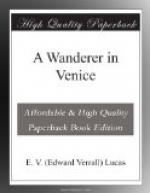I like the women too (forgive
my folly!),
From the rich
peasant cheek of ruddy bronze,
And large black eyes that
flash on you a volley
Of rays that say
a thousand things at once,
To the high Dama’s brow,
more melancholy,
But clear, and
with a wild and liquid glance,
Heart on her lips, and soul
within her eyes,
Soft as her clime, and sunny
as her skies.
Byron’s next visit to Venice was in 1818, and it was then that he set up state and became a Venetian lion. He had now his gondolas, his horses on the Lido, a box at the Opera, many servants. But his gaiety had left him. Neither in his letters nor his verse did he recapture the fun which we find in Beppo. To this second period belong such graver Venetian work (either inspired here or written here) as the opening stanzas of the fourth canto of Childe Harold. The first line takes the reader into the very heart of the city and is one of the best-known single lines in all poetry. Familiar as the stanzas are, it would be ridiculous to write of Byron in Venice without quoting them again:—
I stood in Venice, on the
“Bridge of Sighs”;
A Palace and a
prison on each hand:
I saw from out the wave her
structures rise
As from the stroke
of the Enchanter’s wand:
A thousand Years their cloudy
wings expand
Around me, and
a dying Glory smiles
O’er the far times,
when many a subject land
Looked to the
winged Lion’s marble piles,
Where Venice sate
in state, throned on her hundred isles.
She looks a sea Cybele, fresh
from Ocean,
Rising with her
tiara of proud towers
At airy distance, with majestic
motion,
A ruler of the
waters and their powers:
And such she was;—her
daughters had their dowers
From spoils of
nations, and the exhaustless East
Poured in her lap all gems
in sparkling showers.
In purple was
she robed, and of her feast
Monarchs partook,
and deemed their dignity increased.
[Illustration: THE BAPTISM OF CHRIST FROM THE PAINTING BY CIMA In the Church of S. Giovanni in Bragora]
Byron wrote also, in 1818, an “Ode on Venice,” a regret for its decay, in spirit not unlike the succeeding Childe Harold stanzas which I do not here quote. Here too he planned Marino Faliero, talking it over with his guest, “Monk” Lewis. Another Venetian play of Byron’s was The Two Foscari, and both prove that he attacked the old chronicles to some purpose and with all his brilliant thoroughness. None the less he made a few blunders, as when in The Two Foscari there is an allusion to the Bridge of Sighs, which was not, as it happens, built for more than a century after the date of the play.
No city, however alluring, could be Byron’s home for long, and this second sojourn in Venice was not made any simpler by the presence of his daughter Ada. In 1819 he was away again and never returned. No one so little liked the idea of being rooted as he; at a blow the home was broken.




